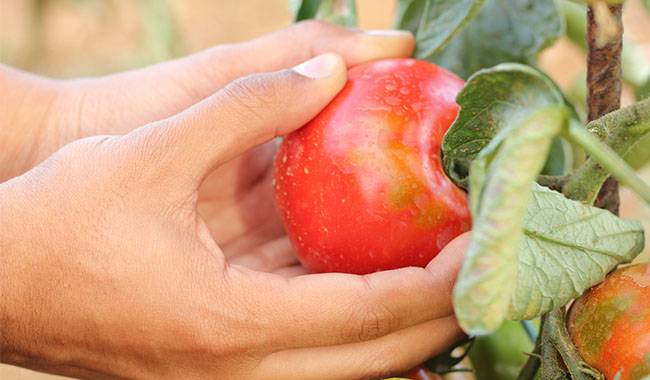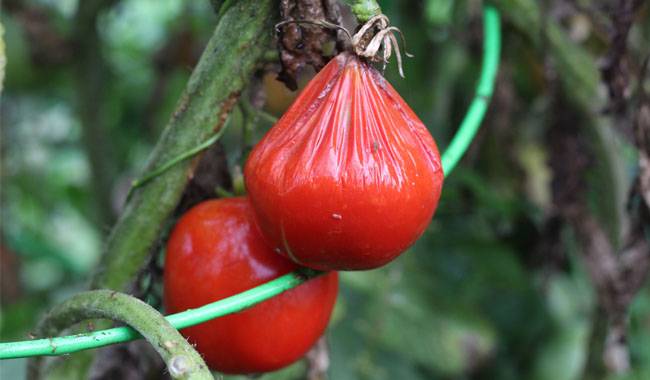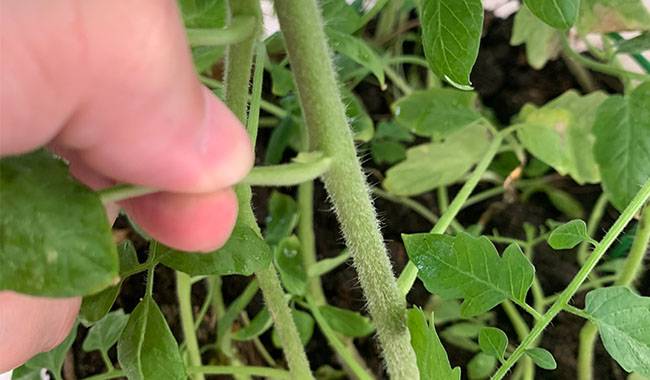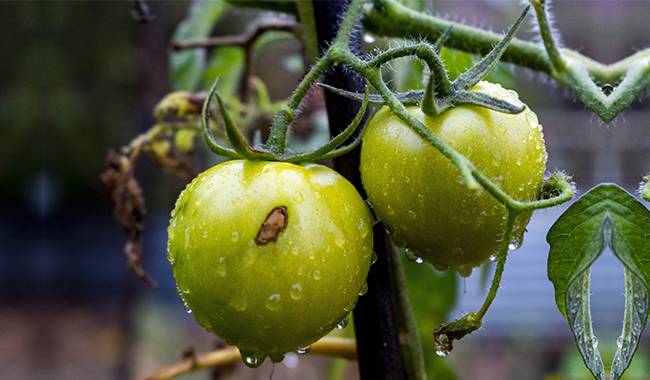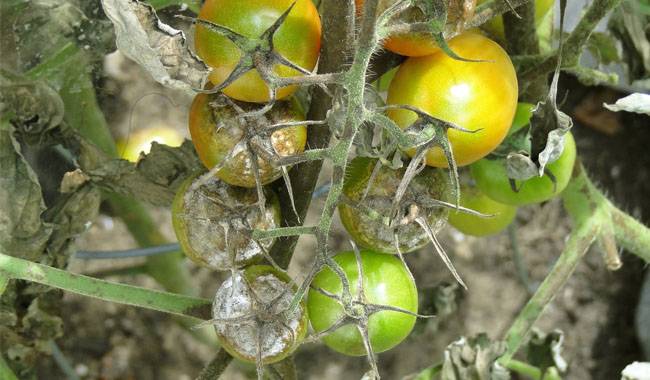
Not everyone who grows tomatoes enjoys the long time to wait until it can be harvest. There are some troubles at every stage in the growth of these southern vegetables. But even the most insidious of pests cannot destroy an entire tomato crop as quickly as of late blight.
Under favorable conditions, it can cause damage to all crops in greenhouses and vegetable gardens in a matter of days. Fruit from infected shrubs is believed to be unsuitable for storage and processing, even if there are no traces of late blight. When this disease appears in tomatoes, you need to take immediate action. What to spray tomatoes to control late blight, I will show you in this article.
RAPID RESPONSE TO LATE BLIGHT – THE KEY TO SUCCESSFUL CONTROL
Midsummer, with its high humidity and day and night temperature differences, provides ideal conditions for the spread of tomatoes’ main enemy – late blight. It can kill as much as half the crop if you delay fighting its spread – and almost the entire harvest of tomatoes in the location.
But don’t panic if you find late blight on your tomato plants. It’s dangerous, rapidly spreading the disease of Solanaceae and some other garden crops that are hard to stop, but possible. And the sooner you enable effective methods to control late blight, the less damage to the harvest will be solved.
All methods of controlling late blight on tomatoes can be divided into three categories:
- folk remedies.
- chemical means.
- biological agents.
The selection of methods for the control of late blight deserves priority for systemic solutions – they involve both the treatment of diseased tomatoes, the protection of healthy plants, and the prevention of late blight in the future.
FOLK METHODS OF PHYLLOXERA CONTROL IN TOMATOES
The use of natural or easy methods and infusions to control dangerous garden diseases is quite effective. Late blight is not an exception, although it reproduces super fast and is very aggressive.
Solutions and infusions, when used regularly and at an early stage of control, are milder than pesticides, but not always worse. After decades of practice, they have proven safe for crops and garden ecosystems.
WHAT ARE SOME FOLK REMEDIES FOR SPRAYING TOMATOES TO CONTROL LATE BLIGHT?
For example.
- garlic infusion (1.5 cups of chopped heads with stems poured into 10 liters of water, add 2 grams of manganese and stick to it for a day, then use 100 to 200 ml, depending on the height of each plant shrub).
- Soaking wood ash (5 liters of wood ash per 10 liters of water, soak for 3 days, filter, and dilute with water at a ratio of 1 to 3).
- Yeast solution (100 g of pressed yeast per 10 liters of water, but this spraying is only effective when alternating with other treatments).
- soda water solution (2 tbsp of soda water per 10 liters of water with liquid or laundry soap).
- mushroom brew (100 g of chopped dried mushrooms per 1 liter of water).
- milk spray (1 liter of milk mixed with 20 drops of iodine and diluted in 10 liters of water)
- sour milk solution (yogurt or kefir diluted with water in the ratio of 1 to 10)
- vinegar solution (100 ml of vinegar per 10 liters of water), which is effective only when used alternately with other methods.
- Brine solution (1 cup of sea salt or table salt per 10 liters of water) is effective only after removing all damaged leaves.
Treat with folk remedies immediately after the infestation is found and repeat at intervals of 7 to 10 days. Spraying should be done carefully and cover the entire plant evenly. For efficiency, you can add some manganese (2 grams per 10 liters), iodine (15-20 drops per 10 liters), green (40 drops per 10 liters of water), laundry soap (30-35 grams per 10 liters), and hydrogen peroxide (2 tablespoons per 1 liter of water) to these folk remedies.
One of the easiest ways to prevent and stop the spread of late blight is mulching. It is not only useful for the soil but also preserves the texture of the soil. Mulching reduces humidity, eliminates favorable conditions for late blight, promotes active development of microorganisms, and effectively kills late blight spores.
This does not mean that mulched tomatoes are not affected by late blight. They do, but it’s easier. If you haven’t mulched your tomatoes before, it’s good to put mulch underneath them after spraying with folk remedies.
Also, gardeners have come up with a number of very novel but effective ways to control late blight.
- using copper wire as a barrier against late blight (a piece of calcined copper wire is used to pierce the mature, strong trunk of the adult plant at a height of 1.6-2inch (4-5cm) above the ground, with the ends bent for safety).
- “Wash white” with toothpaste solution (1 tube per 10L of water).
- Treat with steam or shower with hot water-no less than 140°F (60°C).
FUNGICIDES AGAINST LATE BLIGHT
The most effective, fastest, and easiest way to fight late blight is to use fungicides. To fight this dangerous disease, it helps between long known and simple types of antifungal drugs, and novelty pesticides. But usually, any remedy has a basis of at least one copper-containing component.
Among the classical means of combating late blight are.
- Bordeaux mixture (applied in the form of a 1% solution)
- copper sulfate (1 tablespoon per 10 liters of water)
- Boric acid (1 tablespoon per 10 liters of water)
- Furacilin (1 tablet per 1L of water)
- Calcium chloride (ratio of 1 preparation per 100 parts of water, i.e. 1% solution).
It is best to start spraying tomatoes affected by late blight as soon as possible. Late blight readily adapts to these preparations and it is best to alternate them and change the control strategy for the following season.
Usually, three treatments with fungicides are necessary for phylloxera-affected tomatoes, but the number of treatments per season may be increased to seven in cases of neglect and in the case of extensive planting in greenhouses and seedbeds. In terms of spraying schedule, it is worth noting that the fruit can be harvested no earlier than 2 to 3 weeks after fungicide treatment.
In order for the fungicide to work, it must be studied carefully and the instructions must be followed strictly. By following the dose, frequency of treatment, and even the timing of spraying recommended by the manufacturer, you will soon be able to cope with late blight on tomatoes.
WHAT BIOLOGICAL AGENTS ARE USED TO SPRAYING TOMATOES FOR LATE BLIGHT CONTROL?
Microbial preparations with fungicidal properties – an ecological means of late blight control. Biological agents form long-term Biological agents that work not only locally, but also systemically.
They are based on natural enemies of plant pathogens – bacteria and fungi, preventing and stopping plant pathogens and many other diseases by suppressing pathogenic bacteria and pathogens. Useful microorganisms enhance plant immunity, improve soil health, activate their microflora, and restore biological balance.
Bio fungicides cannot compete with insecticides in terms of speed of action, so one should not expect an immediate and direct effect from the use of prepared formulations. But the absolute safety, positive impact on the soil, long-term effects compensate for the delay.
Biological preparations not only destroy late blight spores but also reliably protect the fruit for a long time and increase the yield without affecting the fruit (tomatoes are edible regardless of the treatment).
PECULIARITIES OF TOMATO DISEASE CONTROL TREATMENT
Regardless of the chosen method of struggle, it is worth remembering that late blight quickly “adapts” to various means and they need to be replaced periodically. The exceptions are innovative systemic fungicides and biological agents that do not cause addiction.
Even when using simple folk remedies and infusions, it is better to choose a sunny, windless day and treat tomatoes in the early morning or late afternoon. Any method requires the use of personal protective equipment and refusal to use metal containers and tools for preparing solutions.
Means that will help save tomatoes from phytophthora can be used not only for spraying already diseased bushes. The use of dips and decoctions and their application on affected plants, after planting tomatoes in the soil, can also prevent phylloxera. However, for adult shrubs, as well as for seedlings, seeds, and soil, microbial and chemical agents can be used.
On tomatoes, late blight is most often obtained from potatoes. When treating tomato plants, it is worth stocking up on spores and spraying potato plants at the same time, because potato plants can harbor spores that become a source of the disease next time.




